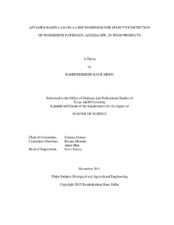| dc.contributor.advisor | Gomes, Carmen | |
| dc.creator | Sidhu, Raminderdeep Kaur | |
| dc.date.accessioned | 2016-05-04T13:21:20Z | |
| dc.date.available | 2017-12-01T06:36:12Z | |
| dc.date.created | 2015-12 | |
| dc.date.issued | 2015-11-20 | |
| dc.date.submitted | December 2015 | |
| dc.identifier.uri | https://hdl.handle.net/1969.1/156446 | |
| dc.description.abstract | This research investigated impedimetric lab-on-a-chip biosensors for selective detection of foodborne pathogen, Listeria spp., using aptamers. Listeria was chosen as a model target due to its impact on the agricultural and food industries. The overall research goal of this project is to bridge the gap to address the need for real-time, highly sensitive and reliable biosensing platforms to meet the demands of on-site analysis of food products. The research objective was to develop a miniaturized aptamer biosensor that was designed and fabricated to carry out the detection of the bacteria in a simple and practical way. Miniaturization of the sensor enhanced the sensitivity and response time and allowed integration of various functionalities as a lab-on-a-chip platform. The research methods utilized the bottom-up approach of nanotechnology and dielectrophoresis techniques to improve the performance of miniaturized sensor. Pt-IMEs were functionalized with internalin A aptamers for selective binding of internalins in the cell membrane of the target bacteria, Listeria spp., via metal-thiol self-assembly. The aptamer biosensor was validated by taking measurements to detect foodborne pathogen, Listeria monocytogenes, in an off-the-shelf food product, i.e. vegetable broth at bacteria concentrations ranging from 10 to 10^7 CFU/mL. The sensitivity value was calculated to be 186.51 Ω/log(CFU/mL)] with the detection limit of 4.82 ± 0.01 CFU/mL within 12 min, which is one of the lowest detection limits reported to date.
The combination of biosensor miniaturization, aptamer functionalization of electrodes, electrochemical impedance spectroscopy and dielectrophoresis techniques for selective detection of Listeria spp. bacteria enhanced response time, limit of detection, range of bacteria concentration, sensitivity and selectivity over other published biosensors. The developed aptasensor could be easily employed for the detection of other foodborne pathogenic bacteria to ensure food safety and public health. | en |
| dc.format.mimetype | application/pdf | |
| dc.language.iso | en | |
| dc.subject | Impedimetric Biosensor | en |
| dc.subject | Platinum Interdigitated Microelectrode Arrays | en |
| dc.subject | Dielectrophoresis | en |
| dc.subject | Viable And Non-Viable Bacteria | en |
| dc.subject | Thiolated Aptamers | en |
| dc.title | Aptamer Based Lab-on-a-chip Biosensor for Selective Detection of Foodborne Pathogen, Listeria Spp., in Food Products | en |
| dc.type | Thesis | en |
| thesis.degree.department | Biological and Agricultural Engineering | en |
| thesis.degree.discipline | Biological and Agricultural Engineering | en |
| thesis.degree.grantor | Texas A & M University | en |
| thesis.degree.name | Master of Science | en |
| thesis.degree.level | Masters | en |
| dc.contributor.committeeMember | Moreira, Rosana | |
| dc.contributor.committeeMember | Han, Arum | |
| dc.type.material | text | en |
| dc.date.updated | 2016-05-04T13:21:20Z | |
| local.embargo.terms | 2017-12-01 | |
| local.etdauthor.orcid | 0000-0001-6555-597X | |


